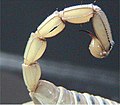Tail


Tail[edit]
The tail is a distinct and typically flexible appendage attached to the posterior or base of the torso in numerous animals. Notably seen in vertebrates, certain invertebrates also exhibit tail-like structures. Tails have evolved to serve a multitude of functions, ranging from aiding locomotion in aquatic species to acting as a form of communication in social animals. Objects or organisms exhibiting a tail-like structure can be termed as "caudate", and any part of the body near or associated with the tail is described as "caudal".
Anatomy[edit]
Tails are analogous to the sacrum and coccyx in mammals, reptiles, and birds. Some invertebrates, such as scorpions, springtails, as well as snails and slugs, possess structures that can be considered as tail-like.
Function[edit]
Locomotion[edit]
In aquatic environments, tails in creatures like fish serve as vital propellers for movement.
Balance[edit]
Animals like cats and kangaroos utilize their tails to maintain equilibrium. Additionally, certain species such as New World monkeys and opossums possess prehensile tails, allowing them to latch onto objects like tree branches.
Social Signaling[edit]
Tails play a role in animal communication. Deer, for instance, flash the white underside of their tails as a danger signal, while canids, including dogs, convey emotions via tail position and movement.
Defensive Mechanisms[edit]
Certain species possess tails equipped with armor or venom, such as scorpions. Some lizards can autonomously shed their tails to divert predators, allowing them to escape. These cast tails can regenerate, although the color might differ from the original.
Avian Adaptations[edit]
Bird tails, terminating in long feathers known as rectrices, aid in steering and balance during flight. Several bird species flaunt modified tail feathers for courtship rituals, like the peafowl. Others, such as woodpeckers, use their tails as supports against tree surfaces.
Grazing Animals[edit]
Tails in animals like horses serve dual purposes: deterring insects and conveying the creature's mental or physical state.
Types[edit]
- Scut: A short, erect tail, commonly found in animals like hares, rabbits, and deer.
- Prehensile Tail: A tail capable of grasping objects, seen in species like monkeys, rats, and in the adaptive bodies of snakes.
Human Tails[edit]
Although adults lack an external tail, human embryos exhibit a tail accounting for roughly one-sixth of their size. As the embryo matures into a fetus, this tail gets absorbed. This remnant of our evolutionary past is deemed a vestigial structure. Occasionally, children are born with a "soft tail" comprising muscles, blood vessels, and nerves. Some of these tails have even shown to contain cartilage or vertebrae.
Tail Bone[edit]
Humans retain a vestigial tail bone called the coccyx, situated at the base of the spine and connected to the pelvis. Composed of typically four fused vertebrae, it remains internal and doesn't manifest externally.
Gallery[edit]
-
Pig (Sus domestica)
-
Glyptodon (Glyptodon asper)
-
Longhorn cowfish (Lactoria cornuta)
-
Grévy's zebra (Equus grevyi)
-
Polo pony (Equus ferus caballus)
-
American alligator (Alligator mississipiensis)
-
Hippopotamus (Hippopotamus amphibius)
See Also[edit]
|
|
|
| Anatomy and morphology | ||||||||||
|---|---|---|---|---|---|---|---|---|---|---|
|
Ad. Transform your life with W8MD's Budget GLP-1 injections from $75


W8MD offers a medical weight loss program to lose weight in Philadelphia. Our physician-supervised medical weight loss provides:
- Weight loss injections in NYC (generic and brand names):
- Zepbound / Mounjaro, Wegovy / Ozempic, Saxenda
- Most insurances accepted or discounted self-pay rates. We will obtain insurance prior authorizations if needed.
- Generic GLP1 weight loss injections from $75 for the starting dose.
- Also offer prescription weight loss medications including Phentermine, Qsymia, Diethylpropion, Contrave etc.
NYC weight loss doctor appointmentsNYC weight loss doctor appointments
Start your NYC weight loss journey today at our NYC medical weight loss and Philadelphia medical weight loss clinics.
- Call 718-946-5500 to lose weight in NYC or for medical weight loss in Philadelphia 215-676-2334.
- Tags:NYC medical weight loss, Philadelphia lose weight Zepbound NYC, Budget GLP1 weight loss injections, Wegovy Philadelphia, Wegovy NYC, Philadelphia medical weight loss, Brookly weight loss and Wegovy NYC
|
WikiMD's Wellness Encyclopedia |
| Let Food Be Thy Medicine Medicine Thy Food - Hippocrates |
Medical Disclaimer: WikiMD is not a substitute for professional medical advice. The information on WikiMD is provided as an information resource only, may be incorrect, outdated or misleading, and is not to be used or relied on for any diagnostic or treatment purposes. Please consult your health care provider before making any healthcare decisions or for guidance about a specific medical condition. WikiMD expressly disclaims responsibility, and shall have no liability, for any damages, loss, injury, or liability whatsoever suffered as a result of your reliance on the information contained in this site. By visiting this site you agree to the foregoing terms and conditions, which may from time to time be changed or supplemented by WikiMD. If you do not agree to the foregoing terms and conditions, you should not enter or use this site. See full disclaimer.
Credits:Most images are courtesy of Wikimedia commons, and templates, categories Wikipedia, licensed under CC BY SA or similar.
Translate this page: - East Asian
中文,
日本,
한국어,
South Asian
हिन्दी,
தமிழ்,
తెలుగు,
Urdu,
ಕನ್ನಡ,
Southeast Asian
Indonesian,
Vietnamese,
Thai,
မြန်မာဘာသာ,
বাংলা
European
español,
Deutsch,
français,
Greek,
português do Brasil,
polski,
română,
русский,
Nederlands,
norsk,
svenska,
suomi,
Italian
Middle Eastern & African
عربى,
Turkish,
Persian,
Hebrew,
Afrikaans,
isiZulu,
Kiswahili,
Other
Bulgarian,
Hungarian,
Czech,
Swedish,
മലയാളം,
मराठी,
ਪੰਜਾਬੀ,
ગુજરાતી,
Portuguese,
Ukrainian










